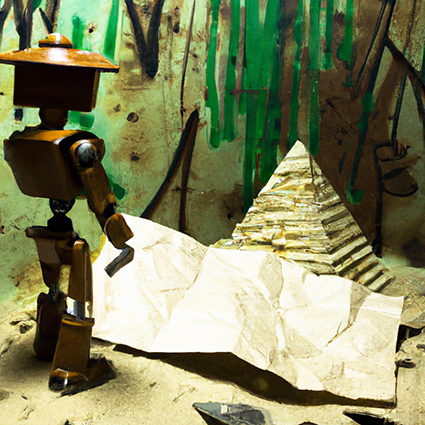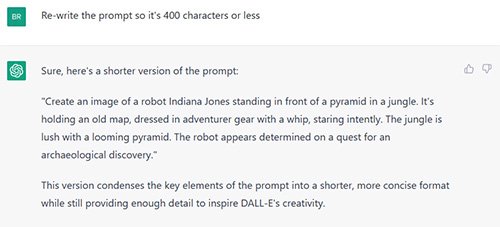How to use ChatGPT to Generate Prompts for AI Art Like Midjourney or DALL-E
Artificial intelligence has opened up a whole new world of possibilities for the creative industry. One of the most exciting applications of AI is generating unique and original pieces of art. Midjourney and DALL-E are two prominent examples of AI-generated art that have captured the attention of artists and art enthusiasts alike. In this article, we will explore how to use ChatGPT to generate prompts for AI art, and provide helpful tips for creating stunning AI-generated artworks.
What exactly is ChatGPT?
ChatGPT is an artificial intelligence. It is a text-based program that can respond to prompts and generate human-ish text that is fluent, coherent, and contextually relevant.
How to Use ChatGPT to Generate Prompts for AI Art
Generating prompts for AI art with ChatGPT is an exciting and creative process. You can give ChatGPT a prompt, and it will generate a series of related phrases, sentences, and paragraphs that you can use as a basis for your AI art project. Here's how to generate a prompt using ChatGPT:
Determine the Art Style and Subject Matter You Want for Your AI Art
Before you begin generating prompts, you should have a clear idea of the art style and subject matter you want for your AI art. Do you want to create a portrait, a landscape, or an abstract piece? Would you like the artwork to be photorealistic or surreal? It's important to decide on the style and subject matter to create an effective prompt.
Write a Prompt
The next step is to write a prompt that describes what you want your AI art to look like. Your prompt should include the essential characteristics of your AI artwork, such as its appearance, color, and composition. Here are some examples of prompts you can use for inspiration:
"Create a portrait of a woman with green hair and purple eyes."
"Generate an abstract piece inspired by the ocean and the colors of a sunset."
"Make a landscape with a waterfall, green trees, and a blue sky."
Here’s a prompt I asked ChatGPT to write.
Here’s the output.
Uh oh. What went wrong? Well. DALL-E is limited to only 400 characters, so the prompt got cut off. So I asked ChatGPT to re-write the prompt.
Here’s the output.
Getting better but still not what I was looking for. ChatGPT is great at injecting colorful language and keywords into your art prompts but you’ll still need to work on them a bit yourself. When ChatGPT was released everyone thought it would replace the writer but this is incorrect. It doesn’t replace the human in the same way the calculator didn’t replace the mathematician. ChatGPT enhances your productivity. It won’t replace you.
I edited the prompt to: An android with an Indian Jones hat, standing in front of an Egyptian pyramid in a jungle. The android is holding an old map, dressed in adventurer gear with a whip on his belt. The jungle is lush with vibrant colors, tropical birds, a snake, with a looming pyramid. The robot appears determined on a quest for an archaeological discovery, in digital art, viewpoint from behind the android.
Here’s the output.
And there we go. Much better. Obviously still not perfect. The map doesn’t look great. But with variations and editing it would definitely get there.
Remember, the original prompt we asked ChatGPT to improve was: a robot that looks like indiana jones, staring at a map, in front of a pyramid in a jungle
When I plugged that into DALL-E I got this:
What is this monstrosity?
As you can see, using ChatGPT to build a prompt, and then editing it produced a much better result.
Input Your Prompt into ChatGPT and Receive Generated Text Outputs
After you have written your prompt, input it into ChatGPT. The model will generate a series of related phrases, sentences, and paragraphs based on your prompt. These generated text outputs can be used to inspire and guide your AI art project.
Keywords and Their Effects on Generated Outputs
Using certain keywords in your prompts can greatly alter the generated outputs. For example, if you use the word "stained glass window" in your prompt, the generated text outputs may include words like "vibrant," "colorful," or "mosaic." Here are some examples of prompts that use keywords to influence the generated outputs:
"Create an art deco-inspired piece with geometric shapes and metallic tones."
"Generate a stained glass window with a celestial theme, incorporating stars and planets."
"Make a surrealist artwork with dreamlike landscapes and abstract elements."
Tips for Creating Successful AI-Generated Art
Creating successful AI-generated art is not just about generating a good prompt; it's also about crafting a compelling and visually appealing piece. Here are some tips to make your AI-generated art as successful as possible:
Experiment with Different Prompts and Text Outputs
To create a truly unique and exciting piece of AI-generated art, you should experiment with different prompts and text outputs. Try inputting various prompts and see how the generated text outputs differ. You may find that one prompt generates more interesting and compelling text outputs than another.
Use High-Quality Images as a Reference
To create a visually appealing piece of AI-generated art, you should use high-quality images as a reference. You can use stock photos, your own photographs, or even artwork by other artists as inspiration. Having a reference image will help you create a more realistic and visually appealing piece of AI art. If you check out a stock photo website and click on a photo, it’ll usually have a bunch of keywords associated with it. You can use those keywords as ideas for your AI-generated art.
Adjust the Generated Output to Fit Your Vision
While the generated text outputs from ChatGPT can be a great starting point for your AI art project, they may not be precisely what you envisioned. Don't be afraid to adjust the text outputs to fit your vision. For example, you can change the color palette, composition, or texture of your AI-generated art to better suit your creative vision. Remember that the generated text outputs are just a starting point, and you have the freedom to adjust and experiment as much as you like.
Use High-Quality AI Art Tools
To create high-quality AI-generated art, you should use the best AI art tools available. Midjourney and DALL-E are two great examples of AI art tools that produce stunning and visually appealing pieces of art. These tools use complex algorithms to generate highly detailed and realistic images that are both beautiful and thought-provoking.
Share Your Art with Others
Posting your artwork on social media or online art communities can help you receive feedback and inspiration from other artists and art enthusiasts. You never know, your AI-generated art may even go viral and gain widespread attention.
Generating prompts for AI art with ChatGPT is a fun and creative process that can lead to stunning and original artworks. By using keywords to influence the generated outputs and following the tips provided in this article, you can create unique and visually appealing pieces of AI-generated art that rival the works of Midjourney and DALL-E. Remember to experiment, adjust, and share your art with others, and you may be surprised by the results. Good luck!





















